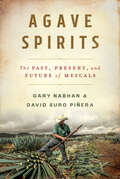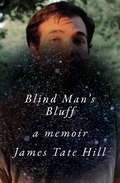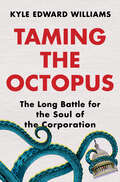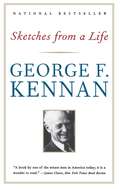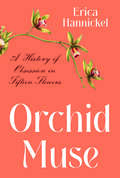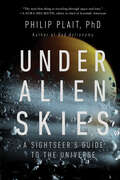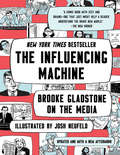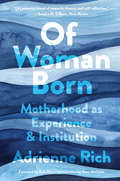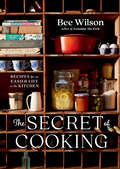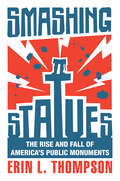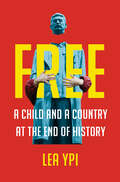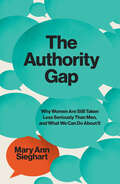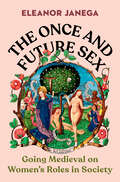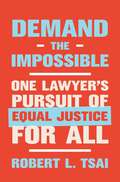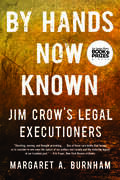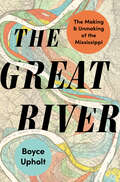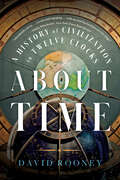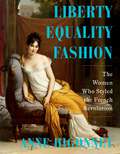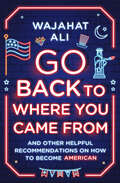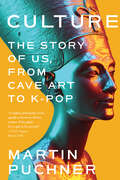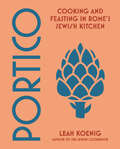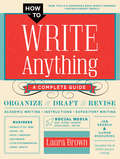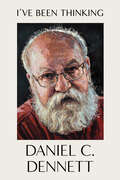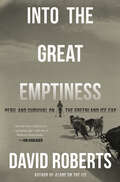- Table View
- List View
Agave Spirits: The Past, Present, And Future Of Mezcals
by Gary Paul Nabhan David Suro Piñera“A manifesto…[and] a positive spin on the future of mezcal.” —Florence Fabricant, New York Times The agave plant was never destined to become tasteless, cheap tequila. All tequilas are mezcals; all mezcals are made from agaves; and every bottle of mezcal is the remarkable result of collaborations among agave entrepreneurs, botanists, distillers, beverage distributors, bartenders, and more. How these groups come together in this “spirits world” is the subject of this fascinating new book by the acclaimed ethnobotanist Gary Paul Nabhan and the pioneering restauranteur David Suro Piñera. Join them as they delight in the diversity of the distillate agave spirits, as they endeavor to track down the more distant kin in the family of agaves, and as, along the way, they reveal the stunning innovations that have been transforming the industry around tequilas and mezcals in recent decades. The result of the authors’ fieldwork and on-the-ground interviews with mezcaleros in eight Mexican states, Agave Spirits shows how traditional methods of mezcal production are inspiring a new generation of individuals, including women, both in and beyond the industry. And as they reach back into a rich, centuries-long history, Nabhan and Suro Piñera make clear that understanding the story behind a bottle of mezcal, more than any other drink, will not only reveal what lies ahead for the tradition—including its ability to adapt in the face of the climate crisis—but will also enrich the drinking experience for readers. Essential reading for mezcal connoisseurs and amateurs interested in unlocking the past of a delightful distillate, Agave Spirits tells the tale of the most flavorful and memorable spirits humankind has ever sipped and savored. Featuring twelve illustrations by René Alejandro Hernández Tapia and indices that list common and scientific names for agave species, as well as the names of plants, animals, and domesticated agaves used in the production of distillates.
Invitation to a Banquet: The Story of Chinese Food
by Fuchsia DunlopThe world’s most sophisticated gastronomic culture, brilliantly presented through a banquet of thirty Chinese dishes. Chinese was the earliest truly global cuisine. When the first Chinese laborers began to settle abroad, restaurants appeared in their wake. Yet Chinese has the curious distinction of being both one of the world’s best-loved culinary traditions and one of the least understood. For more than a century, the overwhelming dominance of a simplified form of Cantonese cooking ensured that few foreigners experienced anything of its richness and sophistication—but today that is beginning to change. In Invitation to a Banquet, award-winning cook and writer Fuchsia Dunlop explores the history, philosophy, and techniques of Chinese culinary culture. In each chapter, she examines a classic dish, from mapo tofu to Dongpo pork, knife-scraped noodles to braised pomelo pith, to reveal a distinctive aspect of Chinese gastronomy, whether it’s the importance of the soybean, the lure of exotic ingredients, or the history of Buddhist vegetarian cuisine. Meeting food producers, chefs, gourmets, and home cooks as she tastes her way across the country, Fuchsia invites readers to join her on an unforgettable journey into Chinese food as it is cooked, eaten, and considered in its homeland. Weaving together history, mouthwatering descriptions of food, and on-the-ground research conducted over the course of three decades, Invitation to a Banquet is a lively, landmark tribute to the pleasures and mysteries of Chinese cuisine.
Blind Man's Bluff: A Memoir
by James Tate HillA writer’s humorous and often-heartbreaking tale of losing his sight—and how he hid it from the world. <p><p> At age sixteen, James Tate Hill was diagnosed with Leber’s hereditary optic neuropathy, a condition that left him legally blind. When high-school friends stopped calling and a disability counselor advised him to aim for C’s in his classes, he tried to escape the stigma by pretending he could still see. In this unfailingly candid yet humorous memoir, Hill discloses the tricks he employed to pass for sighted, from displaying shelves of paperbacks he read on tape to arriving early on first dates so women would have to find him. He risked his life every time he crossed a street, doing his best to listen for approaching cars. A good memory and pop culture obsessions like Tom Cruise, Prince, and all things 1980s allowed him to steer conversations toward common experiences. <p><p> For fifteen years, Hill hid his blindness from friends, colleagues, and lovers, even convincing himself that if he stared long enough, his blurry peripheral vision would bring the world into focus. At thirty, faced with a stalled writing career, a crumbling marriage, and a growing fear of leaving his apartment, he began to wonder if there was a better way.
Taming the Octopus: The Long Battle for the Soul of the Corporation
by Kyle Edward WilliamsThe untold story of how efforts to hold big business accountable changed American capitalism. Recent controversies around environmental, social, and governance (ESG) investing and “woke capital” evoke an old idea: the Progressive Era vision of a socially responsible corporation. By midcentury, the notion that big business should benefit society was a consensus view. But as Kyle Edward Williams’s brilliant history, Taming the Octopus, shows, the tools forged by New Deal liberals to hold business leaders accountable, such as the Securities and Exchange Commission, narrowly focused on the financial interests of shareholders. This inadvertently laid the groundwork for a set of fringe views to become dominant: that market forces should rule every facet of society. Along the way, American capitalism itself was reshaped, stripping businesses to their profit-making core. In this vivid and surprising history, we meet activists, investors, executives, and workers who fought over a simple question: Is the role of the corporation to deliver profits to shareholders, or something more? On one side were “business statesmen” who believed corporate largess could solve social problems. On the other were libertarian intellectuals such as Milton Friedman and his oft-forgotten contemporary, Henry Manne, whose theories justified the ruthless tactics of a growing class of corporate raiders. But Williams reveals that before the “activist investor” emerged as a capitalist archetype, Civil Rights groups used a similar playbook for different ends, buying shares to change a company from within. As a rising tide of activists pushed corporations to account for societal harms from napalm to environmental pollution to inequitable hiring, a new idea emerged: that managers could maximize value for society while still turning a maximal profit. This elusive ideal, “stakeholder capitalism,” still dominates our headlines today. Williams’s necessary history equips us to reconsider democracy’s tangled relationship with capitalism.
Sketches from a Life
by George F. KennanWritten originally as a series of entries in a travel diary and now considered one of the most important memoirs of our time, Sketches from a Life is George F. Kennan's peerless, impressionistic record of his experiences with twentieth-century history. Beginning with his first foreign service post in 1927 and ending seven decades later, Kennan's account is rich with the insight of a major historical participant. Whether relating the perils of Hitler's Germany or revisiting Kennan's days as ambassador to the Soviet Union, Sketches from a Life is as riveting as great literature, and one of the most invaluable documents of our time.
Orchid Muse: A History Of Obsession In Fifteen Flowers
by Erica HannickelOne of Literary Hub's Most Anticipated Books of 2022 A kaleidoscopic journey into the world of nature’s most tantalizing flower, and the lives it has inspired. The epitome of floral beauty, orchids have long fostered works of art, tales of adventure, and scientific discovery. Tenacious plant hunters have traversed continents to collect rare specimens; naturalists and shoguns have marveled at orchids’ seductive architecture; royalty and the smart set have adorned themselves with their allure. In Orchid Muse, historian and home grower Erica Hannickel gathers these bold tales of the orchid-smitten throughout history, while providing tips on cultivating the extraordinary flowers she features. Consider Empress Eugenie and Queen Victoria, the two most powerful women in nineteenth-century Europe, who shared a passion for Coelogyne cristata, with its cascading, fragrant white blooms. John Roebling, builder of the Brooklyn Bridge, cultivated thousands of orchids and introduced captivating hybrids. Edmond Albius, an enslaved youth on an island off the coast of Madagascar, was the first person to hand-pollinate Vanilla planifolia, leading to vanilla’s global boom. Artist Frida Kahlo was drawn to the lavender petals of Cattleya gigas and immortalized the flower’s wilting form in a harrowing self-portrait, while more recently Margaret Mee painted the orchids she discovered in the Amazon to advocate for their conservation. The story of orchidomania is one that spans the globe, transporting readers from the glories of the palace gardens of Chinese Empress Cixi to a seedy dime museum in Gilded Age New York’s Tenderloin, from hazardous jungles to the greenhouses and bookshelves of Victorian collectors. Lush and inviting, with radiant full-color illustrations throughout, Orchid Muse is the ultimate celebration of our enduring fascination with these beguiling flowers.
Under Alien Skies: A Sightseer's Guide to the Universe
by Philip PlaitA Financial Times Best Science Book of 2023 • A Science News Favorite Book of 2023 • A Scientific American 2023 Staff Recommendation "The next-best thing to traveling through space and time." —Laura Helmuth, editor in chief of Scientific American A rip-roaring tour of the cosmos with the Bad Astronomer, bringing you up close and personal with the universe like never before. Have you ever wondered what it would be like to travel the universe? How would Saturn’s rings look from a spaceship sailing just above them? If you were falling into a black hole, what’s the last thing you’d see before getting spaghettified? While traveling in person to most of these amazing worlds may not be possible—yet—the would-be space traveler need not despair: you can still take the scenic route through the galaxy with renowned astronomer and science communicator Philip Plait. On this lively, immersive adventure through the cosmos, Plait draws ingeniously on both the latest scientific research and his prodigious imagination to transport you to ten of the most spectacular sights outer space has to offer. In vivid, inventive scenes informed by rigorous science—injected with a dose of Plait’s trademark humor—Under Alien Skies places you on the surface of alien worlds, from our own familiar Moon to the far reaches of our solar system and beyond. Try launching yourself onto a two-hundred-meter asteroid, or stargazing from the rim of an ancient volcano on a planet where, from the place you stand, it is eternally late afternoon. Experience the sudden onset of lunar nightfall, the disorientation of walking—or, rather, shuffling—when you weigh almost nothing, the irritation of jagged regolith dust. Glimpse the frigid mountains and plains of Pluto and the cake-like exterior of a comet called 67P. On a planet trillions of miles from Earth, glance down to see the strange, beautiful shadows cast by a hundred thousand stars. For the aspiring extraterrestrial citizen, casual space tourist, or curious armchair traveler, Plait is an illuminating, always-entertaining guide to the most otherworldly views in our universe.
The Influencing Machine (Updated Edition): Brooke Gladstone On The Media
by Brooke Gladstone Josh NeufeldNew York Times Bestseller With a New Afterword “A comic book with zest and brains—one that just might help a reader understand the brave new world.” —The New Yorker A million listeners trust NPR’s Brooke Gladstone to guide them through the complexities of the modern media. Bursting onto the page in vivid comics by acclaimed artist Josh Neufeld, this brilliant radio personality guides us through two millennia of media history, debunking the notion that “The Media” is an external force beyond our control and equipping us to be savvy consumers and shapers of the news. An invaluable introduction to how the media works from one of the acknowledged masters of the industry, this tenth anniversary edition brings the story up to date, with new illustrations and an afterword that offers a deep examination of the rise of social media and the public’s responsibility in a time of division and disinformation.
Of Woman Born: Motherhood As Experience And Institution
by Adrienne RichThe pathbreaking investigation into motherhood and womanhood from an influential and enduring feminist voice, now for a new generation. In Of Woman Born, originally published in 1976, influential poet and feminist Adrienne Rich examines the patriarchic systems and political institutions that define motherhood. Exploring her own experience—as a woman, a poet, a feminist, and a mother—she finds the act of mothering to be both determined by and distinct from the institution of motherhood as it is imposed on all women everywhere. A “powerful blend of research, theory, and self-reflection” (Sandra M. Gilbert, Paris Review), Of Woman Born revolutionized how women thought about motherhood and their own liberation. With a stirring new foreword from National Book Critics Circle Award–winning writer Eula Biss, the book resounds with as much wisdom and insight today as when it was first written.
The Secret of Cooking: Recipes for an Easier Life in the Kitchen
by Bee WilsonA culinary companion to simplify cooking while making it more enjoyable, The Secret of Cooking is packed with solutions for how to make life in the kitchen work better for you, whether you’re cooking for yourself or for a crowd. Do you wish you could cook more, but don’t know where to start? Bee Wilson has spent years collecting cooking “secrets”: ways of speeding cooking up or slowing it down, strategies for days when you are stretched for time, and other ideas for when you can luxuriate in kitchen therapy. Bee holds out a hand to anyone who wants doable, delicious recipes, the kind of unfussy food that makes every day taste better: quick feasts from a can of beans; fast, medium, and slow ragus; and seven ways to cook a carrot. Alongside thoughts on how to cook when you’re alone, with children, or just plain tired, Bee offers 140 recipes including: the simplest chicken stew even the pickiest of eaters (aka children) will love Zucchini and Herb Fritters, a Grated Tomato and Butter Pasta Sauce (with or without shrimp), and other ways of making your box grater work for you salads to savor, like a tuna salad with anchovy dressing leisurely projects like an Aromatic All-Purpose Curry Powder and quicker food for friends (try Bulgar and Eggplant Pilaf with pistachio and lemon) the loveliest red curry sauce you can make in your instant pot universal desserts, or those gluten-free and dairy-free sweets that you can serve no matter who comes over, like a Vegan Pear, Lemon, and Ginger Cake With advice on seasoning, cleaning up, and choosing the best equipment, Wilson reimagines modern cooking and brings the spark back into everyday meals. As Bee says, “There’s still magic in the kitchen, if you know where to look.” Shall we cook?
Smashing Statues: The Rise and Fall of America's Public Monuments
by Erin L. ThompsonA leading expert on the past, present, and future of public monuments in America. An urgent and fractious national debate over public monuments has erupted in America. Some people risk imprisonment to tear down long-ignored hunks of marble; others form armed patrols to defend them. Why do we care so much about statues? Which ones should stay up and which should come down? Who should make these decisions, and how? Erin L. Thompson, the country’s leading expert in the tangled aesthetic, legal, political, and social issues involved in such battles, brings much-needed clarity in Smashing Statues. She lays bare the turbulent history of American monuments and its abundant ironies, from the enslaved man who helped make the statue of Freedom that tops the United States Capitol, to the fervent Klansman fired from sculpting the world’s largest Confederate monument—who went on to carve Mount Rushmore. And she explores the surprising motivations behind contemporary flashpoints, including the toppling of a statue of Columbus at the Minnesota State Capitol, the question of who should be represented on the Women’s Rights Pioneers Monument in Central Park, and the decision by a museum of African American culture to display a Confederate monument removed from a public park. Written with great verve and informed by a keen sense of American history, Smashing Statues gives readers the context they need to consider the fundamental questions for rebuilding not only our public landscape but our nation as a whole: Whose voices must be heard, and whose pain must remain private?
Free: A Child and a Country at the End of History
by Lea YpiShortlisted for the 2021 Baillie Gifford Prize for Non-Fiction Shortlisted for the 2021 Costa Biography Award The Sunday Times Best Book of the Year in Biography and Memoir A Financial Times Best Book of 2021 (Critics' Picks) The New Yorker, Best Books We Read in 2021 Times Literary Supplement Book of the Year 2021 A Guardian Best Book of the Year A reflection on "freedom" in a dramatic, beautifully written memoir of the end of Communism in the Balkans. For precocious 11-year-old Lea Ypi, Albania’s Soviet-style socialism held the promise of a preordained future, a guarantee of security among enthusiastic comrades. That is, until she found herself clinging to a stone statue of Joseph Stalin, newly beheaded by student protests. Communism had failed to deliver the promised utopia. One’s “biography”—class status and other associations long in the past—put strict boundaries around one’s individual future. When Lea’s parents spoke of relatives going to “university” or “graduating,” they were speaking of grave secrets Lea struggled to unveil. And when the early ’90s saw Albania and other Balkan countries exuberantly begin a transition to the “free market,” Western ideals of freedom delivered chaos: a dystopia of pyramid schemes, organized crime, and sex trafficking. With her elegant, intellectual, French-speaking grandmother; her radical-chic father; and her staunchly anti-socialist, Thatcherite mother to guide her through these disorienting times, Lea had a political education of the most colorful sort—here recounted with outstanding literary talent. Now one of the world’s most dynamic young political thinkers and a prominent leftist voice in the United Kingdom, Lea offers a fresh and invigorating perspective on the relation between the personal and the political, between values and identity, posing urgent questions about the cost of freedom.
The Authority Gap: Why Women Are Still Taken Less Seriously Than Men, and What We Can Do About It
by Mary Ann SieghartAn incisive, intersectional look at the mother of all gender biases: a resistance to women’s authority and power. Every woman has a story of being underestimated, ignored, challenged, or patronized in the workplace. Maybe she tried to speak up in a meeting, only to be talked over by male colleagues. Or a client addressed her male subordinate instead of her. Despite the progress we’ve made toward equality, we still fail, more often than we might realize, to take women as seriously as men. In The Authority Gap, journalist Mary Ann Sieghart examines the wide-ranging implications of this critical gender bias. She explores its intersections with race and class biases and the measures we can take to bridge the gap. With precision and insight, she marshals a wealth of data from a variety of disciplines—including psychology, sociology, politics, and business—and interviews pioneering women like Booker Prize winner Bernardine Evaristo and Janet Yellen. The Authority Gap offers a “a credible roadmap that is capable of taking women from the margins to the center” (Mary McAleese, former president of Ireland).
The Once and Future Sex: Going Medieval on Women's Roles in Society
by Eleanor JanegaNamed a Most Anticipated Book of 2023 by The Millions A vibrant and illuminating exploration of medieval thinking on women’s beauty, sexuality, and behavior. What makes for the ideal woman? How should she look, love, and be? In this vibrant, high-spirited history, medievalist Eleanor Janega turns to the Middle Ages, the era that bridged the ancient world and modern society, to unfurl its suppositions about women and reveal what’s shifted over time—and what hasn’t. Enshrined medieval thinkers, almost always male, subscribed to a blend of classical Greek and Roman philosophy and Christian theology for their concepts of the sexes. For the height of female attractiveness, they chose the mythical Helen of Troy, whose imagined pear shape, small breasts, and golden hair served as beauty’s epitome. Casting Eve’s shadow over medieval women, they derided them as oversexed sinners, inherently lustful, insatiable, and weak. And, unless a nun, a woman was to be the embodiment of perfect motherhood. In contrast, drawing on accounts of remarkable and subversive medieval women like Eleanor of Aquitaine and Hildegard of Bingen, along with others hidden in documents and court cases, Janega shows us how real women of the era lived. While often mothers, they were industrious farmers, brewers, textile workers, artists, and artisans and paved the way for new ideas about women’s nature, intellect, and ability. In The Once and Future Sex, Janega unravels the restricting expectations on medieval women and the ones on women today. She boldly questions why, if our ideas of women have changed drastically over time, we cannot reimagine them now to create a more equitable future.
Demand the Impossible: One Lawyer's Pursuit Of Equal Justice For All
by Robert L. TsaiHow four Supreme Court cases in recent years—all argued and won by one indomitable lawyer—are central to the pursuit of equal justice in America. Stephen Bright emerged on the scene as a cause lawyer in the early decades of mass incarceration, when inflammatory politics and harsh changes to criminal justice policy were crashing down on the most vulnerable members of society. He dedicated his career to unleashing social change by representing clients that society had long ago discarded, and advocated for all to receive a fair trial. In Demand the Impossible, Robert L. Tsai traces Bright’s remarkable career to explore the legal ideas that were central to his relentless pursuit of equal justice. For nearly forty years, Bright led the Southern Center for Human Rights, a nonprofit that provided legal aid to incarcerated people and worked to improve conditions within the justice system. He argued four capital cases before the US Supreme Court—and won each one, despite facing an increasingly hostile bench. With each victory, he brought to light how the law itself had become corrupted by the country’s thirst for severe punishment, exposing prosecutorial misconduct, continuing racial inequality, inadequate safeguards for people with intellectual disabilities, and the shameful quality of legal representation for the poor. Organized around these four major Supreme Court cases, each narrated in vivid and dramatic detail, Tsai’s essential account explores the racism built into the criminal justice system and the incredible advancements one lawyer and his committed allies made for equal rights. An electrifying work of legal history, Demand the Impossible reveals how change can be won in even the most challenging times and how seemingly small victories can go on to have outsized effects.
By Hands Now Known: Jim Crow's Legal Executioners
by Margaret A. BurnhamA Finalist for the 2022 Kirkus Prize for Nonfiction One of NPR's Books We Love in 2022 • Named a Best Book of the Year: The New Yorker, Oprah Daily, Kirkus, Chicago Public Library, and Publishers Weekly A paradigm-shifting investigation of Jim Crow–era violence, the legal apparatus that sustained it, and its enduring legacy, from a renowned legal scholar. If the law cannot protect a person from a lynching, then isn’t lynching the law? In By Hands Now Known, Margaret A. Burnham, director of Northeastern University’s Civil Rights and Restorative Justice Project, challenges our understanding of the Jim Crow era by exploring the relationship between formal law and background legal norms in a series of harrowing cases from 1920 to 1960. From rendition, the legal process by which states make claims to other states for the return of their citizens, to battles over state and federal jurisdiction and the outsize role of local sheriffs in enforcing racial hierarchy, Burnham maps the criminal legal system in the mid-twentieth-century South, and traces the unremitting line from slavery to the legal structures of this period and through to today. Drawing on an extensive database, collected over more than a decade and exceeding 1,000 cases of racial violence, she reveals the true legal system of Jim Crow, and captures the memories of those whose stories have not yet been heard.
The Great River: The Making and Unmaking of the Mississippi
by Boyce UpholtA sweeping history of the Mississippi River—and the centuries of human meddling that have transformed both it and America. The Mississippi River lies at the heart of America, an undeniable life force that is intertwined with the nation’s culture and history. Its watershed spans almost half the country, Mark Twain’s travels on the river inspired our first national literature, and jazz and blues were born in its floodplains and carried upstream. In this landmark work of natural history, Boyce Upholt tells the epic story of this wild and unruly river, and the centuries of efforts to control it. Over thousands of years, the Mississippi watershed was home to millions of Indigenous people who regarded “the great river” with awe and respect, adorning its banks with astonishing spiritual earthworks. The river was ever-changing, and Indigenous tribes embraced and even depended on its regular flooding. But the expanse of the watershed and the rich soils of its floodplain lured European settlers and American pioneers, who had a different vision: the river was a foe to conquer. Centuries of human attempts to own, contain, and rework the Mississippi River, from Thomas Jefferson’s expansionist land hunger through today’s era of environmental concern, have now transformed its landscape. Upholt reveals how an ambitious and sometimes contentious program of engineering—government-built levees, jetties, dikes, and dams—has not only damaged once-vibrant ecosystems but may not work much longer. Carrying readers along the river’s last remaining backchannels, he explores how scientists are now hoping to restore what has been lost. Rich and powerful, The Great River delivers a startling account of what happens when we try to fight against nature instead of acknowledging and embracing its power—a lesson that is all too relevant in our rapidly changing world.
About Time: A History Of Civilization In Twelve Clocks
by David RooneyA captivating, surprising history of timekeeping and how it has shaped our world. For thousands of years, people of all cultures have made and used clocks, from the city sundials of ancient Rome to the medieval water clocks of imperial China, hourglasses fomenting revolution in the Middle Ages, the Stock Exchange clock of Amsterdam in 1611, Enlightenment observatories in India, and the high-precision clocks circling the Earth on a fleet of GPS satellites that have been launched since 1978. Clocks have helped us navigate the world and build empires, and have even taken us to the brink of destruction. Elites have used them to wield power, make money, govern citizens, and control lives—and sometimes the people have used them to fight back. Through the stories of twelve clocks, About Time brings pivotal moments from the past vividly to life. Historian and lifelong clock enthusiast David Rooney takes us from the unveiling of al-Jazari’s castle clock in 1206, in present-day Turkey; to the Cape of Good Hope observatory at the southern tip of Africa, where nineteenth-century British government astronomers moved the gears of empire with a time ball and a gun; to the burial of a plutonium clock now sealed beneath a public park in Osaka, where it will keep time for 5,000 years. Rooney shows, through these artifacts, how time has been imagined, politicized, and weaponized over the centuries—and how it might bring peace. Ultimately, he writes, the technical history of horology is only the start of the story. A history of clocks is a history of civilization.
Liberty Equality Fashion: The Women Who Styled the French Revolution
by Anne HigonnetThree women led a fashion revolution and turned themselves into international style celebrities. Joséphine Bonaparte, future Empress of France; Térézia Tallien, the most beautiful woman in Europe; and Juliette Récamier, muse of intellectuals, had nothing left to lose. After surviving incarceration and forced incestuous marriage during the worst violence of the French Revolution of 1789, they dared sartorial revolt. Together, Joséphine and Térézia shed the underwear cages and massive, rigid garments that women had been obliged to wear for centuries. They slipped into light, mobile dresses, cropped their hair short, wrapped themselves in shawls, and championed the handbag. Juliette made the new style stand for individual liberty. The erotic audacity of these fashion revolutionaries conquered Europe, starting with Napoleon. Everywhere a fashion magazine could reach, women imitated the news coming from Paris. It was the fastest and most total change in clothing history. Two centuries ahead of its time, it was rolled back after only a decade by misogynist rumors of obscene extravagance. New evidence allows the real fashion revolution to be told. This is a story for our time: of a revolution that demanded universal human rights, of self-creation, of women empowering each other, and of transcendent glamor
Go Back to Where You Came From: And Other Helpful Recommendations on How to Become American
by Wajahat Ali“Go back to where you came from, you terrorist!” This is just one of the many warm, lovely, and helpful tips that Wajahat Ali and other children of immigrants receive on a daily basis. Go back where, exactly? Fremont, California, where he grew up, but is now an unaffordable place to live? Or Pakistan, the country his parents left behind a half-century ago? Growing up living the suburban American dream, young Wajahat devoured comic books (devoid of brown superheroes) and fielded well-intentioned advice from uncles and aunties. (“Become a doctor!”) He had turmeric stains under his fingernails, was accident-prone, suffered from OCD, and wore Husky pants, but he was as American as his neighbors, with roots all over the world. Then, while Ali was studying at University of California, Berkeley, 9/11 happened. Muslims replaced communists as America’s enemy #1, and he became an accidental spokesman and ambassador of all ordinary, unthreatening things Muslim-y. Now a middle-aged dad, Ali has become one of the foremost and funniest public intellectuals in America. In Go Back to Where You Came From, he tackles the dangers of Islamophobia, white supremacy, and chocolate hummus, peppering personal stories with astute insights into national security, immigration, and pop culture. In this refreshingly bold, hopeful, and uproarious memoir, Ali offers indispensable lessons for cultivating a more compassionate, inclusive, and delicious America.
Culture: The Story Of Us, From Cave Art To K-pop (The\oxford Research Centre In The Humanities/princeton University Press Lectures In European Culture Ser. #1)
by Martin PuchnerNew York Times Editors’ Choice “A mighty, polymathic work, equally at home in all four corners of the globe.… It is a gift to be savored.” —Chris Vognar, Boston Globe In Culture, acclaimed author, professor, and public intellectual Martin Puchner takes us on a breakneck tour through pivotal moments in world history, providing a global introduction to the arts and humanities in one engaging volume. What good are the arts? Why should we care about the past? For millennia, humanity has sought to understand and transmit to future generations not just the “know-how” of life, but the “know-why”—the meaning and purpose of our existence, as expressed in art, architecture, religion, and philosophy. This crucial passing down of knowledge has required the radical integration of insights from the past and from other cultures. In Culture, acclaimed author, professor, and public intellectual Martin Puchner takes us on a breakneck tour through pivotal moments in world history, providing a global introduction to the arts and humanities in one engaging volume. From Nefertiti’s lost city to the plays of Wole Soyinka; from the theaters of ancient Greece to Chinese travel journals to Arab and Aztec libraries; from a South Asian statuette found at Pompeii to a time capsule left behind on the Moon, Puchner tells the gripping story of human achievement through our collective losses and rediscoveries, power plays and heroic journeys, innovations, imitations, and appropriations. More than a work of history, Culture is an archive of humanity’s most monumental junctures and a guidebook for the future of us humans as a creative species. Witty, erudite, and full of wonder, Puchner argues that the humanities are (and always have been) essential to the transmission of knowledge that drives the efforts of human civilization.
Portico: Cooking And Feasting In Rome's Jewish Kitchen
by Leah KoenigOne of Food & Wine's Best Cookbooks of Fall 2023 A captivating tour through Rome’s centuries-old Jewish community with more than 100 simple, deeply flavorful, vegetable-forward recipes. “Naming the book Portico is my way of saying, ‘Welcome. I’m glad you are here.’” A leading authority on Jewish food, Leah Koenig celebrates la cucina Ebraica Romana within the pages of her new cookbook. Portico: Cooking and Feasting in Rome’s Jewish Kitchen features over 100 deeply flavorful recipes and beautiful photographs of Rome’s Jewish community, the oldest in Europe. The city’s Jewish residents have endured many hardships, including 300 years of persecution inside the Roman Jewish Ghetto. Out of this strife grew resilience, a deeply knit community, and a uniquely beguiling cuisine. Today, the community thrives on Via del Portico d’Ottavia (the main road in Rome’s Ghetto neighborhood)—and beyond. Leah Koenig’s recipes showcase the cuisine’s elegantly understated vegetables, saucy braised meats and stews, rustic pastas, resplendent olive oil–fried foods, and never-too-sweet desserts. Home cooks can explore classics of the Roman Jewish repertoire with Stracotto di Manzo (a wine-braised beef stew), Pizza Ebraica (fruit-and-nut-studded bar cookies), and, of course, Carciofi alla Giudia, the quintessential Jewish-style fried artichokes. A standout chapter on fritters—showcasing the unique gift Roman Jews have for delicate frying—includes sweet honey-soaked matzo fritters, fried salt cod, and savory potato pastries (burik) introduced by the thousands of Libyan Jews who immigrated to Rome in the 1960s and ’70s. Every recipe is masterfully tailored to the home cook, while maintaining the flavor and integrity of tradition. Suggested menus for holiday planning round out the usability and flexibility of these dishes. A cookbook for anyone who wants to dive more deeply into Jewish foodways, or gain new insight into Rome, Portico features the makers and creators who are keeping Roman Jewish food alive today, transporting us to the bustling streets of the Eternal City while also making us feel—as we cook and eat—very much at home.
How to Write Anything: A Complete Guide
by Laura Brown“There has never been a guide as comprehensive as this to writing in all its forms. . . . Useful, clear and encyclopedic, this book is an essential guide for every household.”—Examiner Need to know how to format your résumé for that job application? How do you write a cover letter that will stand out? Wondering how to request a letter of recommendation for graduate school? Trying to craft a get-well note that will really help? How informal is too informal when instant messaging in the office? What do you write on the website for your small business? What should you say in a wedding invitation? Or a divorce announcement? With over 200 how-to entries and easy-to-use models organized into three comprehensive sections on work, school, and personal life, How to Write Anything covers a wide range of topics that make it an essential guide for the whole family.
I've Been Thinking
by Daniel C. Dennett"How unfair for one man to be blessed with such a torrent of stimulating thoughts. Stimulating is an understatement." —Richard Dawkins A memoir by one of the greatest minds of our age, preeminent philosopher and cognitive scientist Daniel C. Dennett. Daniel C. Dennett, preeminent philosopher and cognitive scientist, has spent his career considering the thorniest, most fundamental mysteries of the mind. Do we have free will? What is consciousness and how did it come about? What distinguishes human minds from the minds of animals? Dennett’s answers have profoundly shaped our age of philosophical thought. In I’ve Been Thinking, he reflects on his amazing career and lifelong scientific fascinations. Dennett’s relentless curiosity has taken him from a childhood in Beirut and the classrooms of Harvard, Oxford, and Tufts, to “Cognitive Cruises” on sailboats and the fields and orchards of Maine, and to laboratories and think tanks around the world. Along the way, I’ve Been Thinking provides a master class in the dominant themes of twentieth-century philosophy and cognitive science—including language, evolution, logic, religion, and AI—and reveals both the mistakes and breakthroughs that shaped Dennett’s theories. Key to this journey are Dennett’s interlocutors—Douglas Hofstadter, Marvin Minsky, Willard Van Orman Quine, Gilbert Ryle, Richard Rorty, Thomas Nagel, John Searle, Gerald Edelman, Stephen Jay Gould, Jerry Fodor, Rodney Brooks, and more—whose ideas, even when he disagreed with them, helped to form his convictions about the mind and consciousness. Studded with photographs and told with characteristic warmth, I’ve Been Thinking also instills the value of life beyond the university, one enriched by sculpture, music, farming, and deep connection to family. Dennett compels us to consider: What do I really think? And what if I’m wrong? This memoir by one of the greatest minds of our time will speak to anyone who seeks to balance a life of the mind with adventure and creativity.
Into the Great Emptiness: Peril And Survival On The Greenland Ice Cap
by David RobertsThe riveting story of one of the greatest but least-known sagas in the history of exploration from David Roberts, the “dean of adventure writing.” By 1930, no place in the world was less well explored than Greenland. The native Inuit had occupied the relatively accessible west coast for centuries. The east coast, however, was another story. In August 1930, Henry George Watkins (nicknamed “Gino”), a twenty-three-year-old British explorer, led thirteen scientists and explorers on an ambitious expedition to the east coast of Greenland and into its vast and forbidding interior to set up a permanent meteorological base on the icecap, 8,200 feet above sea level. The Ice Cap Station was to be the anchor of a transpolar route of air travel from Europe to North America. The weather on the ice cap was appalling. Fierce storms. Temperatures plunging lower than –50° Fahrenheit in the winter. Watkins’s scheme called for rotating teams of two men each to monitor the station for two months at a time. No one had ever tried to winter over in that hostile landscape, let alone manage a weather station through twelve continuous months. Watkins was younger than anyone under his command. But he had several daring trips to the Arctic under his belt and no one doubted his judgement. The first crisis came in the fall when a snowstorm stranded a resupply mission halfway to the top for many weeks. When they arrived at the ice cap, there were not enough provisions and fuel for another two-man shift, so the station would have to be abandoned. Then team member August Courtauld made an astonishing offer. To enable the mission to go forward, he would monitor the station solo through the winter. When a team went up in March to relieve Courtauld, after weeks of brutal effort to make the 130-mile journey, they could find no trace of him or the station. By the end of March, Courtauld’s situation was desperate. He was buried under an immovable load of frozen snow and was disastrously short on supplies. On April 21, four months after Courtauld began his solitary vigil, Gino Watkins set out inland with two companions to find and rescue him. David Roberts, “veteran mountain climber and chronicler of adventures” (Washington Post), draws on firsthand accounts and archival materials to tell the story of this daring expedition and of the epic survival ordeal that ensued.
